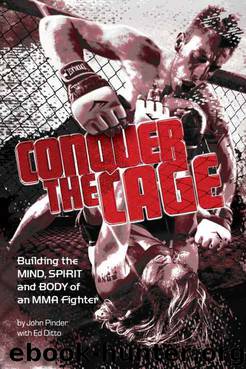Conquer the Cage by Ditto Ed & Pinder John

Author:Ditto, Ed & Pinder, John [Ditto, Ed]
Language: eng
Format: epub
Published: 2011-12-13T16:00:00+00:00
Body - Strength Training
Just as MMA-style cardio is different from “ordinary” cardio, MMA-style strength training is different from powerlifting training or strongman training. Like MMA-style cardio work, MMA strength work is designed to simulate what you’ll experience in the cage.
Strength is a huge part of success in MMA. If you take two fighters of equal talent and skill, but one’s stronger than the other, the stronger fighter will dominate. Especially in grappling action. Technique is paramount, but you need to be a hard hitter, too, and hard hits come from a good strength base.
When I first got into Jujitsu I relied on my strength a lot. I was holding guys down and getting them into arm bars, chokes, and locks, but if they tried those movements on me, I was strong enough to power out of them. But even I can’t rely solely on strength for the entire fight—eventually anyone will get gassed out.
That said, a lot of people get away from lifting as they get more and more into MMA. Weightlifting establishes a good strength foundation, but it can almost be counterproductive. If you’re lifting three or four days a week it’s going to be difficult to fit your martial arts classes in like you should. And that’s going to inhibit your conditioning. To see why, imagine doing a heavy squat day and then going to an MMA class and trying to do ninety minutes of circuits. You’ll be dead on your feet.
Weightlifting can also cost you flexibility. For example, squatting and deadlifting tighten up your hips. I’ve got one trainee with such tight hips that he can’t throw head kicks, which are a big part of the arsenal in kickboxing. So I’ve cut back his weightlifting and started him on some flexibility drills.
Choosing between strength and flexibility is a tradeoff, though, because all your power is generated from your hips. For example, if you’re throwing a straight right you twist your hips to the left so your whole body weight comes into the punch. It’s the same with Jujitsu—you control your opponent with your hips. Even when you’re grappling, everything comes from your core. That’s why deadlifting is so important in martial arts, because that’s how you build core strength.
During the time I was most heavily engaged in MMA training I only lifted about twice a month. And I lost some muscle mass, but the more heavily muscled you are, the more oxygen it takes to support that mass. So when you’re big your conditioning suffers. That’s why you don’t see that many heavily-muscled guys in martial arts. There are a few, but these guys don’t always do as well in later rounds as the smaller, wirier guys.
You’ll also try to time your weight training depending on when your fights are. If you don’t have a fight coming up for six months you’ll be lifting to build your strength base. But when you’re about twelve weeks out you’ll start emphasizing your technique and conditioning work. And you won’t
Download
This site does not store any files on its server. We only index and link to content provided by other sites. Please contact the content providers to delete copyright contents if any and email us, we'll remove relevant links or contents immediately.
Shoe Dog by Phil Knight(5147)
The Rules Do Not Apply by Ariel Levy(4868)
Walking by Henry David Thoreau(3897)
How to Read Water: Clues and Patterns from Puddles to the Sea (Natural Navigation) by Tristan Gooley(3410)
Running Barefoot by Amy Harmon(3398)
I'll Give You the Sun by Jandy Nelson(3362)
Crazy Is My Superpower by A.J. Mendez Brooks(3334)
How to Read Nature by Tristan Gooley(3252)
How Music Works by David Byrne(3191)
The Boy, the Mole, the Fox and the Horse by Charlie Mackesy(3002)
The Fight by Norman Mailer(2849)
Seducing Cinderella by Gina L. Maxwell(2604)
Cuba by Lonely Planet(2579)
Accepted by Pat Patterson(2309)
Going Long by Editors of Runner's World(2298)
The Unfettered Mind: Writings from a Zen Master to a Master Swordsman by Takuan Soho(2249)
The Happy Runner by David Roche(2195)
Backpacker the Complete Guide to Backpacking by Backpacker Magazine(2194)
Trail Magic by Trevelyan Quest Edwards & Hazel Edwards(2127)
